Inside the Playbook - Going 4-3 (Over) MSU's Front 7
Originally posted June 27, 2013 at Maize n Brew
Introduction
When looking at Michigan State's defense, there are two things that will be seen on almost every single play: 4-3 over front and cover 4 behind it. Unlike the coverage portion of the defense, the front 7 plays fairly similar to most of their 4-3 over counterparts. In this part of the series, I want to look at what a 4-3 over defense is, what some of the weaknesses to the front are, and how MSU adjusts in an attempt to mask the inherent weakness of the front 7 scheme.
For reference, here's the gap scheme:
4-3 Over
* EDIT: MSU does not teach slow pursuit. Their cover 4 scheme allows for the backside safety to clean up any bounce back or reverse field type angles. Instead, MSU teaches to sprint over top of the play to prevent any cutback playside, or to attack "clear" (vs running over the top vs. "cloudy") to meet the pulling lineman or ball carrier in the backfield.
You can see above that this is a fairly simple defense to run out of its base. Each D-linemen is responsible for a single gap. The LBs are essentially two gapping, playing inside out.
One thing you will notice though is that this defense presents bubbles, 3 bubbles in fact: strong-side C; strong-side A; and weak-side B. Some of these are easier for offenses to attach than others, but they do present an offensive advantage because they allow offensive linemen to either get free releases to the second level or to have good blocking angles on defensive linemen.
So if it's such a weak rush defense, why has MSU been so good at rush defense? There's many reasons for that, including the backend coverage. But what we're going to focus on today is what the front 7 does to defend the run, namely defensive line adjustments and aggressive LB play.
More after the jump
Defensive Line Adjustments
I'll start off with a video directly from MSU Defensive Coordinator Pat Narduzzi (found thanks to our SB Nation Brethren "The Only Colors")
Thanks Pat, that's a helpful starting point. Let's go ahead and summarize this now.
Base 4-3 Over
Your base 4-3 over front is safe. It covers everything fairly well and is relatively balanced. It's a good formation to stop the run to the strong side (the side which most teams predominately run to). It's also set up relatively well to rush the passer, and allows for an expanded blitz package. It's greatest weakness is the weakside ISO play. Let's diagram that and show why.
As you can see, the offensive line can get a solid double on the NT. The NT is lined up close enough to the Center for the Center to quickly take over the block and the WOG (weakside offensive guard) has a good angle at the MIKE. The 5 tech DE can be kicked out by the WOT, and the FB has a direct block to the WILL. Because it's a relatively large gap for the WILL to defend, it is very difficult, even if he quickly attacks and fills, for the WILL to successfully stop the play. WILL would prefer to keep the play inside by attacking with his inside shoulder, keeping his outside arm free, as more help defense is in the middle of the field rather than outside. If the ball carrier can break outside the defense will give up big yards.
Other plays that work well: weakside inside zone; weakside power with a pulling center (if you have a center that can do that sort of thing). Mostly, it's the ISO though.
So what did MSU do when they played a team that loves to run weakside ISO, Boise State?
Over G
One of the front adjustments Narduzzi mentioned was the Over G.
By simply sliding the NT from a 1-tech to a 2-tech, which is the same gap just a different shoulder. Now the center has a much more difficult time to overtake the NT and allow the OG to get to the next level. The angle the center has on the MIKE is either too steep to likely beat him to the spot or the NT is still too much in the way to get the correct angle. On top of that, the NT must be doubled because he must be rooted out of that position, otherwise the running lane shrinks and congests when you throw in the WILL, FB, and then RB. MSU typically does this when the weakside of the formation is to the field.
Here's some video:
Unfortunately for MSU, this really opens up the fold draw and the trap play (which teams inexplicably don't run nearly enough anymore). Here's a look at the fold draw.
Note a huge play necessarily this time, but picking up 5 yards on the ground against MSU with the potential to break more is better than most get out of the situation.
This is why it's not just run all the time.
Over I
The Over I is used to stop plays like power, or more so, to stop sweeps to the outside and strong side zone runs. Because the DT is lined up over top of the OT, the OT struggles to get to the second level and LBs become difficult to block because the offensive line doesn't have the angle to reach them. This is why this formation will be run against a lot of twin TE sides.
The weakness here is now ISO to either side or any sort of weakside run.
DE Pinch
In the film I watched I didn't see a lot of Jam or Cage, but the concept was still used quite a bit, so here are diagrams.
Jam:
Cage:
Jam is often used when there is a TE and two WR to a single side of the field. The reason to run this isn't really much about the run at all, but actually the pass. By lining up the DE over the TE and jamming him, you allow the MIKE to react first to pass and give him time to react and drop and pick up the #3 receiver (TE). Meanwhile, the DE has slide down in gap responsibility to the C gap. This allows the SDE to have D gap responsibility. Because he has outside responsibility, it allows him to have initial motion toward the flat, allowing him to get out quicker in coverage.
The same can be said for Cage coverage. It allows the WILL to have C gap responsibility and get out into the flat.
Here's video of MSU running a DE pinch type front.
Notre Dame goes deep and doesn't attack the flat, but you can see the position of the WILL already gaining ground toward the flat, despite even taking a few steps to bite on the run action. Because he has C gap responsibility, he doesn't need to bust across the formation or over commit.
Here's video of them not.
This is a bit unfair because of the action away from the play, which likely would have drawn the OLB to a degree regardless, but it does demonstrate the ground he is forced to make up by having to defend an inside gap against the run and the flat against the pass.
What this type of thing is used more often for is to set up the blitz. By pinching the DE, the DE is able to get into the inside shoulder of his blocker (TE for SDE, OT for WDE) and turn him. One the blocker is turned, it is nearly impossible for the blocker to react and pick up the corner blitz.
MSU loves to blitz the boundary corner against nub (no WR on that side) formations.
Conclusion
So while the 4-3 over has some weaknesses, MSU makes up for it in a variety of ways. This includes very small but significant alignment changes on the D-line. It also involves blitzing from the secondary and LB level. One thing that wasn't mentioned much, if at all, also deals with the fact that MSU runs a cover 4. That is, the cover 4 allows the LBs to be very aggressive and downhill. While the weaknesses and strengths of this coverage will be discussed next time, the combination of the front seven and back end coverage is a big reason why MSU defense has been so successful.
Introduction
When looking at Michigan State's defense, there are two things that will be seen on almost every single play: 4-3 over front and cover 4 behind it. Unlike the coverage portion of the defense, the front 7 plays fairly similar to most of their 4-3 over counterparts. In this part of the series, I want to look at what a 4-3 over defense is, what some of the weaknesses to the front are, and how MSU adjusts in an attempt to mask the inherent weakness of the front 7 scheme.
For reference, here's the gap scheme:
4-3 Over
| Side | Align Tech | Key | Run To | Run Away | Pass |
| Strong | 9 tech | TE | D Gap | C Gap - Chase | Left Outside Contain |
| Strong | 3 tech | OG | B Gap | B Gap - Squeeze A Gap | B Gap |
| Weak | 1 tech | C | A Gap | A Gap | A Gap |
| Weak | 5 tech | OT | C Gap | C Gap - Chase | C Gap |
| Strong | 60 tech | OG to RBs | C Gap | A Gap - Slow Pursuit* | |
| Strong | Strong 00 | C to RBs | A Gap | B Gap | |
| Weak | 40 tech | OG to RBs | C Gap | Slow Pursuit* |
* EDIT: MSU does not teach slow pursuit. Their cover 4 scheme allows for the backside safety to clean up any bounce back or reverse field type angles. Instead, MSU teaches to sprint over top of the play to prevent any cutback playside, or to attack "clear" (vs running over the top vs. "cloudy") to meet the pulling lineman or ball carrier in the backfield.
You can see above that this is a fairly simple defense to run out of its base. Each D-linemen is responsible for a single gap. The LBs are essentially two gapping, playing inside out.
So if it's such a weak rush defense, why has MSU been so good at rush defense? There's many reasons for that, including the backend coverage. But what we're going to focus on today is what the front 7 does to defend the run, namely defensive line adjustments and aggressive LB play.
More after the jump
Defensive Line Adjustments
I'll start off with a video directly from MSU Defensive Coordinator Pat Narduzzi (found thanks to our SB Nation Brethren "The Only Colors")
Base 4-3 Over
As you can see, the offensive line can get a solid double on the NT. The NT is lined up close enough to the Center for the Center to quickly take over the block and the WOG (weakside offensive guard) has a good angle at the MIKE. The 5 tech DE can be kicked out by the WOT, and the FB has a direct block to the WILL. Because it's a relatively large gap for the WILL to defend, it is very difficult, even if he quickly attacks and fills, for the WILL to successfully stop the play. WILL would prefer to keep the play inside by attacking with his inside shoulder, keeping his outside arm free, as more help defense is in the middle of the field rather than outside. If the ball carrier can break outside the defense will give up big yards.
Other plays that work well: weakside inside zone; weakside power with a pulling center (if you have a center that can do that sort of thing). Mostly, it's the ISO though.
So what did MSU do when they played a team that loves to run weakside ISO, Boise State?
Over G
One of the front adjustments Narduzzi mentioned was the Over G.
Here's some video:
Unfortunately for MSU, this really opens up the fold draw and the trap play (which teams inexplicably don't run nearly enough anymore). Here's a look at the fold draw.
Also, the power
This is why it's not just run all the time.
Over I
The weakness here is now ISO to either side or any sort of weakside run.
DE Pinch
In the film I watched I didn't see a lot of Jam or Cage, but the concept was still used quite a bit, so here are diagrams.
Jam:
The same can be said for Cage coverage. It allows the WILL to have C gap responsibility and get out into the flat.
Here's video of MSU running a DE pinch type front.
Here's video of them not.
What this type of thing is used more often for is to set up the blitz. By pinching the DE, the DE is able to get into the inside shoulder of his blocker (TE for SDE, OT for WDE) and turn him. One the blocker is turned, it is nearly impossible for the blocker to react and pick up the corner blitz.
Conclusion
So while the 4-3 over has some weaknesses, MSU makes up for it in a variety of ways. This includes very small but significant alignment changes on the D-line. It also involves blitzing from the secondary and LB level. One thing that wasn't mentioned much, if at all, also deals with the fact that MSU runs a cover 4. That is, the cover 4 allows the LBs to be very aggressive and downhill. While the weaknesses and strengths of this coverage will be discussed next time, the combination of the front seven and back end coverage is a big reason why MSU defense has been so successful.
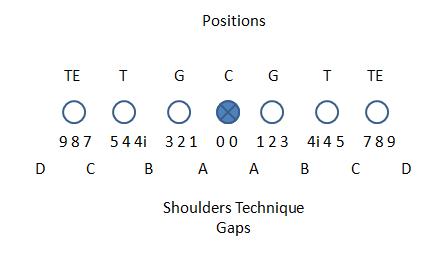
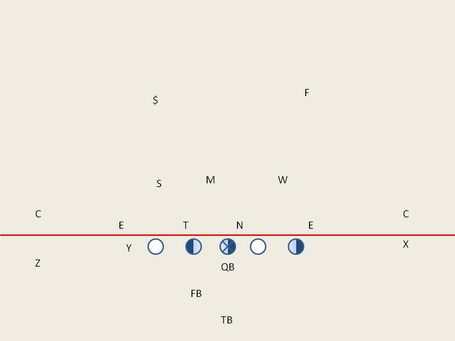
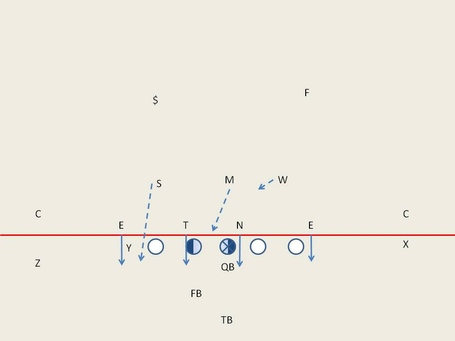
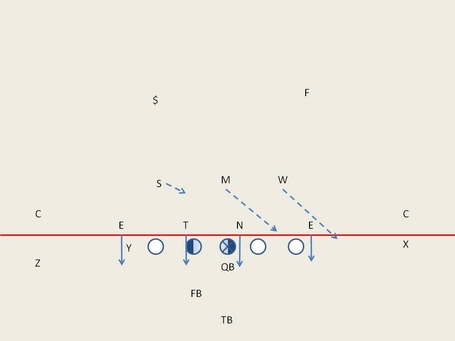


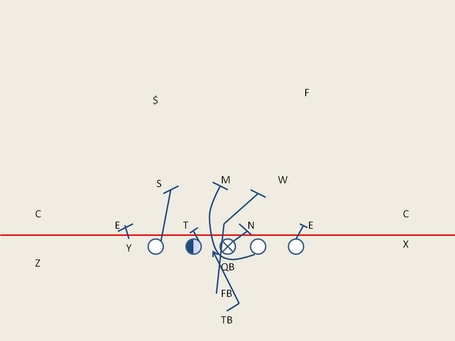


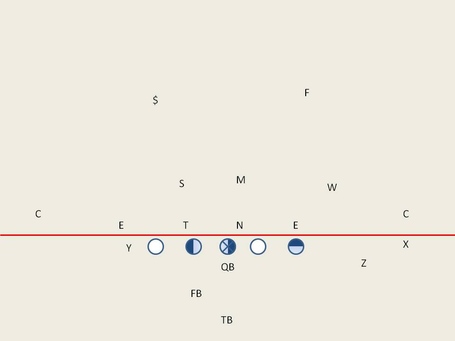



Excellent - so, is MSU able to run this in the absence of outstanding Safeties,DB's? Seems that if there is a weakness there attacking them vertically unfolds this defense. Likewise the counters/traps weak side and even play action that way to catch LB's is a big area to exploit. Is State primarily successful because Narduzzi has had the talent to pull this leveraged defense off or will it work with lesser talent?
ReplyDeleteI write a bit more about the coverage aspects here: http://www.maizenbrew.com/2013/6/28/4473134/mnb-b1g-preview-Michigan-State-Football-Defense-4-3-Over-Cover-4-Breakdown
DeleteBut to answer your questions, I don't think MSU needs outstanding DBs, but they do need technically sound DBs and smart DBs. Luckily for them, they have Dantonio who is one of the better DB coaches in the game (learned from Saban).
This defense does have several weaknesses though: the short flat, one on one match up without much help on the outside, and the safety run/pass conflict. It's the middle one that is attempted to be exploited the most (coaches are afraid to over expose the short flat in case they start jumping the route), but IMO, it's the safeties that should be attacked the most.
Because the safeties have alley support responsibilities, it is very difficult for them to cover the #2 and any outside run threat. OSU exposed this several times with a lot of success in the B1G champtionship game. Then went away from it. MSU has some tweaks to either lessen the safety run responsibility or to get more of a press from their OLBs, but the safety is still the weak link IMO.
And yes, because of MSU's fast flow they can be exploited on traps and counters. But you must make sure you account for the safety coming down in the run game. Swing passes also have some success.
I don't think Narduzzi is successful only because he's putting out great talent. The MSU staff is great at coaching the techniques for their scheme, and so the players are limited in the amount they have to learn but are great at those those. They have good athletes, but notice they are producing a ton of NFL draft picks, for instance. It's a defense that will give up some big plays, and when it's less skilled, can be exploited. But there is also soundness to it. The CBs don't allow WRs inside, meaning you have to make deep passes to the sideline -- a hard throw. It's a 7 man front that is adaptable to heavy and spread personnel and can act as much as 9 in the box, so it's good against the run. There are small tweaks to help safeties out. So it's not just a scheme that relies on having more talent, there is soundness to it. But the technique and understanding of the scheme needs to very high. You can't half ass this scheme and expect to continue to get great results.